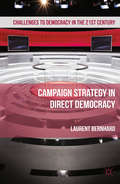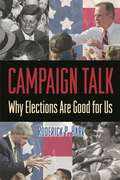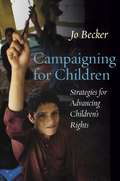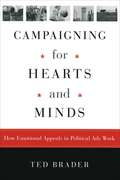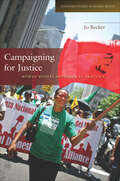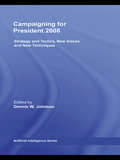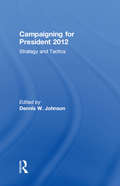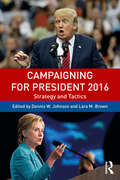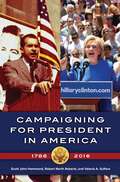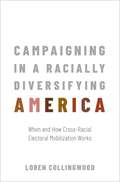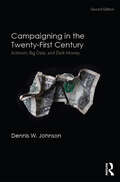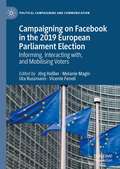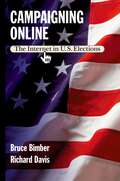- Table View
- List View
Campaign Strategy in Direct Democracy (Challenges to Democracy in the 21st Century)
by Laurent BernhardIn the first study of comparative direct-democracy, Laurent Bernhard explores the nature of direct-democratic campaigning in Switzerland. The author examines four policy areas: immigration, healthcare, welfare and economic liberalism focussing on interviews with campaign managers to provide a comprehensive analysis of direct-democratic campaigning.
Campaign Talk: Why Elections Are Good for Us (PDF)
by Roderick P. HartRoderick Hart may be among the few Americans who believe that what politicians say in a campaign actually matters. He also believes that campaigns work. Even as television coverage, political ads, and opinion polls turn elections into field days for marketing professionals, Hart argues convincingly that campaigns do play their role in sustaining democracy, mainly because they bring about a dialogue among candidates, the press, and the people. Here he takes a close look at the exchange of ideas through language used in campaign speeches, political advertising, public debates, print and broadcast news, and a wide variety of letters to the editor. In each case, the participants choose their words differently, and this, according to Hart, can be a frustrating challenge to anyone trying to make sense of the issues. Yet he finds that the process is good for Americans: campaigns inform us about issues, sensitize us to the concerns of others, and either encourage us to vote or at least heighten our sense of the political world. Hart comes to his conclusions by using DICTION, a computer program that has enabled him to unearth substantive data, such as the many subtle shifts found in political language, over the past fifty years. This approach yields a rich variety of insights, including empirically based explanations of impressions created by political candidates. For example, in 1996 Bill Clinton successfully connected with voters by using many human-interest words--"you," "us," "people," "family." Bob Dole, however, alienated the public and even undermined his own claims of optimism by using an abundance of denial words--"can't," "shouldn't," "couldn't." Hart also tracks issue buzzwords such as "Medicare" to show how candidates and voters define and readjust their positions throughout the campaign dialogue. In the midst of today's increased media hype surrounding elections, Americans and the candidates they elect do seem to be listening to each other--as much as they did in years gone by. Hart's wide-ranging, objective investigation upends many of our stereotypes about political life and presents a new, more bracing, understanding of contemporary electoral behavior.
Campaign Talk: Why Elections Are Good for Us
by Roderick P. HartRoderick Hart may be among the few Americans who believe that what politicians say in a campaign actually matters. He also believes that campaigns work. Even as television coverage, political ads, and opinion polls turn elections into field days for marketing professionals, Hart argues convincingly that campaigns do play their role in sustaining democracy, mainly because they bring about a dialogue among candidates, the press, and the people. Here he takes a close look at the exchange of ideas through language used in campaign speeches, political advertising, public debates, print and broadcast news, and a wide variety of letters to the editor. In each case, the participants choose their words differently, and this, according to Hart, can be a frustrating challenge to anyone trying to make sense of the issues. Yet he finds that the process is good for Americans: campaigns inform us about issues, sensitize us to the concerns of others, and either encourage us to vote or at least heighten our sense of the political world. Hart comes to his conclusions by using DICTION, a computer program that has enabled him to unearth substantive data, such as the many subtle shifts found in political language, over the past fifty years. This approach yields a rich variety of insights, including empirically based explanations of impressions created by political candidates. For example, in 1996 Bill Clinton successfully connected with voters by using many human-interest words--"you," "us," "people," "family." Bob Dole, however, alienated the public and even undermined his own claims of optimism by using an abundance of denial words--"can't," "shouldn't," "couldn't." Hart also tracks issue buzzwords such as "Medicare" to show how candidates and voters define and readjust their positions throughout the campaign dialogue. In the midst of today's increased media hype surrounding elections, Americans and the candidates they elect do seem to be listening to each other--as much as they did in years gone by. Hart's wide-ranging, objective investigation upends many of our stereotypes about political life and presents a new, more bracing, understanding of contemporary electoral behavior.
Campaign Talk: Why Elections Are Good for Us
by Roderick P. HartRoderick Hart may be among the few Americans who believe that what politicians say in a campaign actually matters. He also believes that campaigns work. Even as television coverage, political ads, and opinion polls turn elections into field days for marketing professionals, Hart argues convincingly that campaigns do play their role in sustaining democracy, mainly because they bring about a dialogue among candidates, the press, and the people. Here he takes a close look at the exchange of ideas through language used in campaign speeches, political advertising, public debates, print and broadcast news, and a wide variety of letters to the editor. In each case, the participants choose their words differently, and this, according to Hart, can be a frustrating challenge to anyone trying to make sense of the issues. Yet he finds that the process is good for Americans: campaigns inform us about issues, sensitize us to the concerns of others, and either encourage us to vote or at least heighten our sense of the political world. Hart comes to his conclusions by using DICTION, a computer program that has enabled him to unearth substantive data, such as the many subtle shifts found in political language, over the past fifty years. This approach yields a rich variety of insights, including empirically based explanations of impressions created by political candidates. For example, in 1996 Bill Clinton successfully connected with voters by using many human-interest words--"you," "us," "people," "family." Bob Dole, however, alienated the public and even undermined his own claims of optimism by using an abundance of denial words--"can't," "shouldn't," "couldn't." Hart also tracks issue buzzwords such as "Medicare" to show how candidates and voters define and readjust their positions throughout the campaign dialogue. In the midst of today's increased media hype surrounding elections, Americans and the candidates they elect do seem to be listening to each other--as much as they did in years gone by. Hart's wide-ranging, objective investigation upends many of our stereotypes about political life and presents a new, more bracing, understanding of contemporary electoral behavior.
Campaigning for Children: Strategies for Advancing Children's Rights
by Jo BeckerAdvocates within the growing field of children's rights have designed dynamic campaigns to protect and promote children's rights. This expanding body of international law and jurisprudence, however, lacks a core text that provides an up-to-date look at current children's rights issues, the evolution of children's rights law, and the efficacy of efforts to protect children. Campaigning for Children focuses on contemporary children's rights, identifying the range of abuses that affect children today, including early marriage, female genital mutilation, child labor, child sex tourism, corporal punishment, the impact of armed conflict, and access to education. Jo Becker traces the last 25 years of the children's rights movement, including the evolution of international laws and standards to protect children from abuse and exploitation. From a practitioner's perspective, Becker provides readers with careful case studies of the organizations and campaigns that are making a difference in the lives of children, and the relevant strategies that have been successful—or not. By presenting a variety of approaches to deal with each issue, this book carefully teases out broader lessons for effective social change in the field of children's rights.
Campaigning for Hearts and Minds: How Emotional Appeals in Political Ads Work (Studies in Communication, Media, and Public Opinion)
by Ted BraderIt is common knowledge that televised political ads are meant to appeal to voters' emotions, yet little is known about how or if these tactics actually work. Ted Brader's innovative book is the first scientific study to examine the effects that these emotional appeals in political advertising have on voter decision-making. At the heart of this book are ingenious experiments, conducted by Brader during an election, with truly eye-opening results that upset conventional wisdom. They show, for example, that simply changing the music or imagery of ads while retaining the same text provokes completely different responses. He reveals that politically informed citizens are more easily manipulated by emotional appeals than less-involved citizens and that positive "enthusiasm ads" are in fact more polarizing than negative "fear ads." Black-and-white video images are ten times more likely to signal an appeal to fear or anger than one of enthusiasm or pride, and the emotional appeal triumphs over the logical appeal in nearly three-quarters of all political ads. Brader backs up these surprising findings with an unprecedented survey of emotional appeals in contemporary political campaigns. Politicians do set out to campaign for the hearts and minds of voters, and, for better or for worse, it is primarily through hearts that minds are won. Campaigning for Hearts and Minds will be indispensable for anyone wishing to understand how American politics is influenced by advertising today.
Campaigning for Hearts and Minds: How Emotional Appeals in Political Ads Work (Studies in Communication, Media, and Public Opinion)
by Ted BraderIt is common knowledge that televised political ads are meant to appeal to voters' emotions, yet little is known about how or if these tactics actually work. Ted Brader's innovative book is the first scientific study to examine the effects that these emotional appeals in political advertising have on voter decision-making. At the heart of this book are ingenious experiments, conducted by Brader during an election, with truly eye-opening results that upset conventional wisdom. They show, for example, that simply changing the music or imagery of ads while retaining the same text provokes completely different responses. He reveals that politically informed citizens are more easily manipulated by emotional appeals than less-involved citizens and that positive "enthusiasm ads" are in fact more polarizing than negative "fear ads." Black-and-white video images are ten times more likely to signal an appeal to fear or anger than one of enthusiasm or pride, and the emotional appeal triumphs over the logical appeal in nearly three-quarters of all political ads. Brader backs up these surprising findings with an unprecedented survey of emotional appeals in contemporary political campaigns. Politicians do set out to campaign for the hearts and minds of voters, and, for better or for worse, it is primarily through hearts that minds are won. Campaigning for Hearts and Minds will be indispensable for anyone wishing to understand how American politics is influenced by advertising today.
Campaigning for Hearts and Minds: How Emotional Appeals in Political Ads Work (Studies in Communication, Media, and Public Opinion)
by Ted BraderIt is common knowledge that televised political ads are meant to appeal to voters' emotions, yet little is known about how or if these tactics actually work. Ted Brader's innovative book is the first scientific study to examine the effects that these emotional appeals in political advertising have on voter decision-making. At the heart of this book are ingenious experiments, conducted by Brader during an election, with truly eye-opening results that upset conventional wisdom. They show, for example, that simply changing the music or imagery of ads while retaining the same text provokes completely different responses. He reveals that politically informed citizens are more easily manipulated by emotional appeals than less-involved citizens and that positive "enthusiasm ads" are in fact more polarizing than negative "fear ads." Black-and-white video images are ten times more likely to signal an appeal to fear or anger than one of enthusiasm or pride, and the emotional appeal triumphs over the logical appeal in nearly three-quarters of all political ads. Brader backs up these surprising findings with an unprecedented survey of emotional appeals in contemporary political campaigns. Politicians do set out to campaign for the hearts and minds of voters, and, for better or for worse, it is primarily through hearts that minds are won. Campaigning for Hearts and Minds will be indispensable for anyone wishing to understand how American politics is influenced by advertising today.
Campaigning for Hearts and Minds: How Emotional Appeals in Political Ads Work (Studies in Communication, Media, and Public Opinion)
by Ted BraderIt is common knowledge that televised political ads are meant to appeal to voters' emotions, yet little is known about how or if these tactics actually work. Ted Brader's innovative book is the first scientific study to examine the effects that these emotional appeals in political advertising have on voter decision-making. At the heart of this book are ingenious experiments, conducted by Brader during an election, with truly eye-opening results that upset conventional wisdom. They show, for example, that simply changing the music or imagery of ads while retaining the same text provokes completely different responses. He reveals that politically informed citizens are more easily manipulated by emotional appeals than less-involved citizens and that positive "enthusiasm ads" are in fact more polarizing than negative "fear ads." Black-and-white video images are ten times more likely to signal an appeal to fear or anger than one of enthusiasm or pride, and the emotional appeal triumphs over the logical appeal in nearly three-quarters of all political ads. Brader backs up these surprising findings with an unprecedented survey of emotional appeals in contemporary political campaigns. Politicians do set out to campaign for the hearts and minds of voters, and, for better or for worse, it is primarily through hearts that minds are won. Campaigning for Hearts and Minds will be indispensable for anyone wishing to understand how American politics is influenced by advertising today.
Campaigning for Hearts and Minds: How Emotional Appeals in Political Ads Work (Studies in Communication, Media, and Public Opinion)
by Ted BraderIt is common knowledge that televised political ads are meant to appeal to voters' emotions, yet little is known about how or if these tactics actually work. Ted Brader's innovative book is the first scientific study to examine the effects that these emotional appeals in political advertising have on voter decision-making. At the heart of this book are ingenious experiments, conducted by Brader during an election, with truly eye-opening results that upset conventional wisdom. They show, for example, that simply changing the music or imagery of ads while retaining the same text provokes completely different responses. He reveals that politically informed citizens are more easily manipulated by emotional appeals than less-involved citizens and that positive "enthusiasm ads" are in fact more polarizing than negative "fear ads." Black-and-white video images are ten times more likely to signal an appeal to fear or anger than one of enthusiasm or pride, and the emotional appeal triumphs over the logical appeal in nearly three-quarters of all political ads. Brader backs up these surprising findings with an unprecedented survey of emotional appeals in contemporary political campaigns. Politicians do set out to campaign for the hearts and minds of voters, and, for better or for worse, it is primarily through hearts that minds are won. Campaigning for Hearts and Minds will be indispensable for anyone wishing to understand how American politics is influenced by advertising today.
Campaigning for Hearts and Minds: How Emotional Appeals in Political Ads Work (Studies in Communication, Media, and Public Opinion)
by Ted BraderIt is common knowledge that televised political ads are meant to appeal to voters' emotions, yet little is known about how or if these tactics actually work. Ted Brader's innovative book is the first scientific study to examine the effects that these emotional appeals in political advertising have on voter decision-making. At the heart of this book are ingenious experiments, conducted by Brader during an election, with truly eye-opening results that upset conventional wisdom. They show, for example, that simply changing the music or imagery of ads while retaining the same text provokes completely different responses. He reveals that politically informed citizens are more easily manipulated by emotional appeals than less-involved citizens and that positive "enthusiasm ads" are in fact more polarizing than negative "fear ads." Black-and-white video images are ten times more likely to signal an appeal to fear or anger than one of enthusiasm or pride, and the emotional appeal triumphs over the logical appeal in nearly three-quarters of all political ads. Brader backs up these surprising findings with an unprecedented survey of emotional appeals in contemporary political campaigns. Politicians do set out to campaign for the hearts and minds of voters, and, for better or for worse, it is primarily through hearts that minds are won. Campaigning for Hearts and Minds will be indispensable for anyone wishing to understand how American politics is influenced by advertising today.
Campaigning for Justice: Human Rights Advocacy in Practice (Stanford Studies in Human Rights #49)
by Jo BeckerAdvocates within the human rights movement have had remarkable success establishing new international laws, securing concrete changes in human rights policies and practices, and transforming the terms of public debate. Yet too often, the strategies these advocates have employed are not broadly shared or known. Campaigning for Justice addresses this gap to explain the "how" of the human rights movement. Written from a practitioner's perspective, this book explores the strategies behind some of the most innovative human rights campaigns of recent years. Drawing on interviews with dozens of experienced human rights advocates, the book delves into local, regional, and international efforts to discover how advocates were able to address seemingly intractable abuses and secure concrete advances in human rights. These accounts provide a window into the way that human rights advocates conduct their work, their real-life struggles and challenges, the rich diversity of tools and strategies they employ, and ultimately, their courage and persistence in advancing human rights.
Campaigning for President 2008: Strategy and Tactics, New Voices and New Techniques
by Dennis W. JohnsonIn this important and timely volume, Dennis W. Johnson has assembled an outstanding team of political science and political journalism scholars and veteran campaign consultants to examine the most exciting presidential campaign in memory. Campaigning for President 2008 focuses on the strategies and tactics used by the presidential candidates, the new voices and new techniques used to generate support and persuade voters, and the activities of outside interests trying to influence the outcome. The experienced team of contributors explain how Obama triumphed in the primaries and how Clinton fell short; and how McCain came back from the politically dead. In this fascinating account, the authors examine the brilliant moves, the mistakes and miscalculations, and the tug of forces over which neither campaign had control.
Campaigning for President 2012: Strategy and Tactics, New Voices and New Techniques
by Dennis W. JohnsonIn this important and timely volume, Dennis W. Johnson has assembled an outstanding team of political scientists and political professionals to examine one of the fiercest and most closely fought presidential elections of our time. Like its predecessor on the 2008 race, Campaigning for President 2012: Strategy and Tactics focuses on political management. It is written by both campaigns and elections scholars and practitioners, who highlight the role of political consultants and campaigns while also emphasizing the strategy and tactics employed by the candidates, the national political parties, and outside interests. The contributors explore the general mood of the electorate in the 2012 election, the challenges Obama faced after his first term, the primaries, money, communication, the important issues of the election, and finally the election itself. This is the most comprehensive and broad treatment of the 2012 presidential election available.
Campaigning for President 2012: Strategy and Tactics, New Voices and New Techniques
by Dennis W. JohnsonIn this important and timely volume, Dennis W. Johnson has assembled an outstanding team of political scientists and political professionals to examine one of the fiercest and most closely fought presidential elections of our time. Like its predecessor on the 2008 race, Campaigning for President 2012: Strategy and Tactics focuses on political management. It is written by both campaigns and elections scholars and practitioners, who highlight the role of political consultants and campaigns while also emphasizing the strategy and tactics employed by the candidates, the national political parties, and outside interests. The contributors explore the general mood of the electorate in the 2012 election, the challenges Obama faced after his first term, the primaries, money, communication, the important issues of the election, and finally the election itself. This is the most comprehensive and broad treatment of the 2012 presidential election available.
Campaigning for President 2016: Strategy and Tactics
by Dennis W. Johnson Lara M. BrownComing out of one of the most contentious elections in history, Dennis Johnson and Lara Brown have assembled an outstanding team of authors to examine one of the fiercest and most closely fought presidential elections of our time. Like the 2008 and 2012 editions of Campaigning for President, the 2016 edition combines the talents and insights of political scientists who specialize in campaigns and elections together with seasoned political professionals who have been involved in previous presidential campaigns. Campaigning for President is the only series on presidential campaigns that features both political scientists and professional consultants. This book focuses on the most important questions of this most unusual presidential campaign. What was the appeal of Donald Trump? Has Twitter and social media become the dominant means of communicating? How did fake news, WikiLeaks, and the Russians factor in this election? What happened to the Obama coalition and why couldn’t Hillary Clinton capitalize on it? Hundreds of millions of Super PAC dollars were raised and spent, and much of that was wasted. What happened? Is the wild west of online media the new norm for presidential contests? These and many other questions are answered in the provocative essays by scholars and practitioners. The volume also is packed with valuable appendixes: a timeline of the presidential race, biographical sketches of each candidate, a roster of political consultants, the primary and general election results, exit polls, and campaign spending. New to the 2016 Edition The 2016 presidential contest brings a completely new set of players, policies, and electoral challenges. Like the 2008 and 2012 editions, the authors probe the strategies and tactics of the candidate campaigns and the outside organizations. The chapters focus on Donald Trump and Hillary Clinton, but also look at the Bernie Sanders insurgency, the collapse of the mainstream Republican candidates, and the dynamics of the general election. Chapters also analyze the changes in campaign finance, new technologies, the role of social media, and how fake news and subterfuge might become the new realities of presidential campaigning.
Campaigning for President 2016: Strategy and Tactics
by Dennis W. Johnson Lara M. BrownComing out of one of the most contentious elections in history, Dennis Johnson and Lara Brown have assembled an outstanding team of authors to examine one of the fiercest and most closely fought presidential elections of our time. Like the 2008 and 2012 editions of Campaigning for President, the 2016 edition combines the talents and insights of political scientists who specialize in campaigns and elections together with seasoned political professionals who have been involved in previous presidential campaigns. Campaigning for President is the only series on presidential campaigns that features both political scientists and professional consultants. This book focuses on the most important questions of this most unusual presidential campaign. What was the appeal of Donald Trump? Has Twitter and social media become the dominant means of communicating? How did fake news, WikiLeaks, and the Russians factor in this election? What happened to the Obama coalition and why couldn’t Hillary Clinton capitalize on it? Hundreds of millions of Super PAC dollars were raised and spent, and much of that was wasted. What happened? Is the wild west of online media the new norm for presidential contests? These and many other questions are answered in the provocative essays by scholars and practitioners. The volume also is packed with valuable appendixes: a timeline of the presidential race, biographical sketches of each candidate, a roster of political consultants, the primary and general election results, exit polls, and campaign spending. New to the 2016 Edition The 2016 presidential contest brings a completely new set of players, policies, and electoral challenges. Like the 2008 and 2012 editions, the authors probe the strategies and tactics of the candidate campaigns and the outside organizations. The chapters focus on Donald Trump and Hillary Clinton, but also look at the Bernie Sanders insurgency, the collapse of the mainstream Republican candidates, and the dynamics of the general election. Chapters also analyze the changes in campaign finance, new technologies, the role of social media, and how fake news and subterfuge might become the new realities of presidential campaigning.
Campaigning for President in America, 1788–2016
by Scott John Hammond Robert North Roberts Valerie A. SulfaroWhat does it take to get elected president of the United States—"leader of the free world"? This book gives readers insight into the major issues and events surrounding American presidential elections across more than two centuries, from the earliest years of the Republic through the campaigns of the 21st century.The race for the presidency encapsulates the broader changes in American democratic culture. This book provides insight into the major issues and events surrounding American presidential elections across more than two centuries, from the earliest years of the Republic through the campaigns of the 21st century. Readers will be able to see and understand how presidential campaigns have evolved over time, and how and why the current state of campaigning for president came into being.
Campaigning for President in America, 1788–2016
by Scott John Hammond Robert North Roberts Valerie A. SulfaroWhat does it take to get elected president of the United States—"leader of the free world"? This book gives readers insight into the major issues and events surrounding American presidential elections across more than two centuries, from the earliest years of the Republic through the campaigns of the 21st century.The race for the presidency encapsulates the broader changes in American democratic culture. This book provides insight into the major issues and events surrounding American presidential elections across more than two centuries, from the earliest years of the Republic through the campaigns of the 21st century. Readers will be able to see and understand how presidential campaigns have evolved over time, and how and why the current state of campaigning for president came into being.
Campaigning in a Racially Diversifying America: When and How Cross-Racial Electoral Mobilization Works
by Loren CollingwoodAs the voting public continues to diversify across the United States, political candidates, and particularly white candidates, increasingly recognize the importance of making appeals to voters who do not look like themselves. As history has shown, this has been accomplished with varying degrees of success. During the 2016 election, for example, both Hillary Clinton and Bernie Sanders campaigned vociferously among Latino voters in Nevada's early primary, where nineteen percent of the Democratic caucus consisted of Latinos. Clinton released a campaign message to these voters stating that she was just like their abuela (or grandmother). The message, widely panned, came across as insincere, and Clinton, who otherwise performed well among Latinos nationally, lost by a wide margin to Sanders. On the other hand, in 2013, Bill de Blasio, campaigning for mayor of New York City, appeared with his black son in a commercial aimed against stop and frisk policies. His appeal came across as authentic, and he received a high level of support among black voters. In Campaigning in a Racially Diversifying America, Loren Collingwood develops a theory of Cross-Racial Electoral Mobilization (CRM) to explain why, when, and how candidates of one race or ethnicity act to mobilize voters of another race or ethnicity. Specifically, Collingwood examines how and when white candidates mobilize Latino voters, and why some candidates are more succesful than others. He argues that candidates strategize by weighing the potential costs and benefits of conducting CRM based on the size of the minority electorate (the benefit) and the overall level of white racial hostility (the cost). Extensive cross-racial mobilization is most likely to occur when elections are competitive, institutional barriers to the vote are low, candidates have previously developed a welcoming racial reputation with target voters, whites' attitudes are racially liberal, and the Latino electorate is large and growing. Moreover, candidates who can demonstrate cultural competence and do so repeatedly are much more likely to be successful at making such appeals. The book looks at CRM trends and case studies over the past seventy years to gauge how politics in various places have changed as the American electorate has diversified. It draws on the author's research in over thirty archives in nine states, candidate and survey data, and experimental approaches to assess causality in voter responses to candidate behavior.
Campaigning in a Racially Diversifying America: When and How Cross-Racial Electoral Mobilization Works
by Loren CollingwoodAs the voting public continues to diversify across the United States, political candidates, and particularly white candidates, increasingly recognize the importance of making appeals to voters who do not look like themselves. As history has shown, this has been accomplished with varying degrees of success. During the 2016 election, for example, both Hillary Clinton and Bernie Sanders campaigned vociferously among Latino voters in Nevada's early primary, where nineteen percent of the Democratic caucus consisted of Latinos. Clinton released a campaign message to these voters stating that she was just like their abuela (or grandmother). The message, widely panned, came across as insincere, and Clinton, who otherwise performed well among Latinos nationally, lost by a wide margin to Sanders. On the other hand, in 2013, Bill de Blasio, campaigning for mayor of New York City, appeared with his black son in a commercial aimed against stop and frisk policies. His appeal came across as authentic, and he received a high level of support among black voters. In Campaigning in a Racially Diversifying America, Loren Collingwood develops a theory of Cross-Racial Electoral Mobilization (CRM) to explain why, when, and how candidates of one race or ethnicity act to mobilize voters of another race or ethnicity. Specifically, Collingwood examines how and when white candidates mobilize Latino voters, and why some candidates are more succesful than others. He argues that candidates strategize by weighing the potential costs and benefits of conducting CRM based on the size of the minority electorate (the benefit) and the overall level of white racial hostility (the cost). Extensive cross-racial mobilization is most likely to occur when elections are competitive, institutional barriers to the vote are low, candidates have previously developed a welcoming racial reputation with target voters, whites' attitudes are racially liberal, and the Latino electorate is large and growing. Moreover, candidates who can demonstrate cultural competence and do so repeatedly are much more likely to be successful at making such appeals. The book looks at CRM trends and case studies over the past seventy years to gauge how politics in various places have changed as the American electorate has diversified. It draws on the author's research in over thirty archives in nine states, candidate and survey data, and experimental approaches to assess causality in voter responses to candidate behavior.
Campaigning in the Twenty-First Century: Activism, Big Data, and Dark Money
by Dennis W. JohnsonIn view of the 2016 US election season, the second edition of this book analyzes the way political campaigns have been traditionally run and the extraordinary changes that have occurred since 2012. Dennis W. Johnson looks at the most sophisticated techniques of modern campaigning—micro-targeting, online fundraising, digital communication, the new media—and examines what has changed, how those changes have dramatically transformed campaigning, and what has remained fundamentally the same despite new technologies and communications. Campaigns are becoming more open and free-wheeling, with greater involvement of activists (especially through social media) and average voters alike. At the same time, they have become more professionalized, and the author has experience managing and marketing the process. Campaigning in the Twenty-First Century illustrates the daunting challenges for candidates and professional consultants as they try to get their messages out to voters. Ironically, the more open and robust campaigns become, the greater is the need for seasoned, flexible, and imaginative professional consultants. New to the Second Edition Includes coverage of the 2012 and 2014 elections, looking ahead to 2016. Updates coverage of campaign finance since the landmark Citizens United Supreme Court decision. Adds to the discussion of demographic and technological changes in elections since 2012.
Campaigning in the Twenty-First Century: Activism, Big Data, and Dark Money
by Dennis W. JohnsonIn view of the 2016 US election season, the second edition of this book analyzes the way political campaigns have been traditionally run and the extraordinary changes that have occurred since 2012. Dennis W. Johnson looks at the most sophisticated techniques of modern campaigning—micro-targeting, online fundraising, digital communication, the new media—and examines what has changed, how those changes have dramatically transformed campaigning, and what has remained fundamentally the same despite new technologies and communications. Campaigns are becoming more open and free-wheeling, with greater involvement of activists (especially through social media) and average voters alike. At the same time, they have become more professionalized, and the author has experience managing and marketing the process. Campaigning in the Twenty-First Century illustrates the daunting challenges for candidates and professional consultants as they try to get their messages out to voters. Ironically, the more open and robust campaigns become, the greater is the need for seasoned, flexible, and imaginative professional consultants. New to the Second Edition Includes coverage of the 2012 and 2014 elections, looking ahead to 2016. Updates coverage of campaign finance since the landmark Citizens United Supreme Court decision. Adds to the discussion of demographic and technological changes in elections since 2012.
Campaigning on Facebook in the 2019 European Parliament Election: Informing, Interacting with, and Mobilising Voters (Political Campaigning and Communication)
by Jörg Haßler Melanie Magin Uta Russmann Vicente FenollThis book investigates how political parties from 12 European countries used Facebook to inform, interact with and mobilise voters at the 2019 European Parliament election. Following a joint theoretical framework and method, the results of a content analysis of more than 14,000 Facebook posts are presented. Country specific chapters are followed by analyses of European parties’ Facebook campaigning, the spread of populism and the use of Facebook ads by the parties. The final chapter compares all countries showing that campaigns are more strongly shaped by the national than by the European political context. Facebook is used for campaigning as usual; parties inform and persuade but neglect the platform’s mobilisation and particularly interactive affordances.
Campaigning Online: The Internet in U.S. Elections
by Bruce Bimber Richard DavisAfter a self-assured John F. Kennedy bested a visibly shaky Richard Nixon in their famous 1960 debates, political television, it was said, would henceforth determine elections. Today, many claim the Internet will be the latest medium to revolutionize electoral politics. Candidates invest heavily in web and email campaigns to reach prospective voters, as well as to communicate with journalists, potential donors, and political activists. Do these efforts influence voters, expand democracy, increase the coverage of political issues, or mobilize a shrinking and apathetic electorate? Campaigning Online answers these questions by looking at how candidates present themselves online and how voters respond to their efforts-including whether voters learn from candidates' websites and whether voters' views are affected by what they see. Although the Internet will not lead to a revolution in democracy, it will, Bimber and Davis argue, have consequences: reinforcing messages, mobilizing activists, and strengthening partisans' views. Reporting on a wealth of new data drawn from national and state-wide surveys, laboratory experiments, interviews with campaign staff, and analysis of web sites themselves, Campaigning Online draws the most complete picture of the role of campaign websites in American elections to date.
